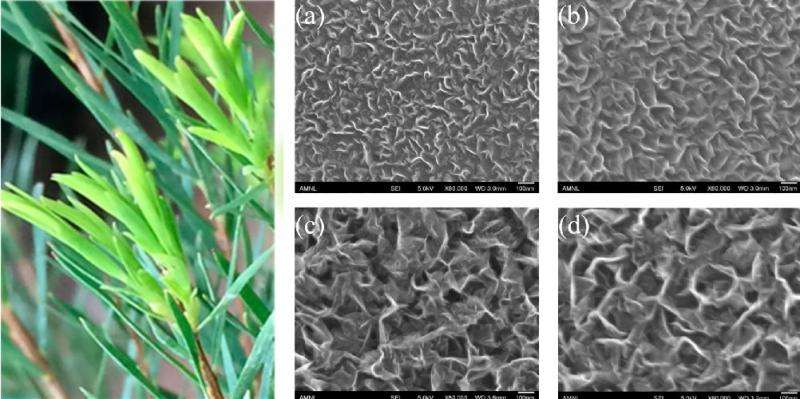August 21, 2015 feature
Scientists grow high-quality graphene from tea tree extract

(Phys.org)—Graphene has been grown from materials as diverse as plastic, cockroaches, Girl Scout cookies, and dog feces, and can theoretically be grown from any carbon source. However, scientists are still looking for a graphene precursor and growth method that is sustainable, scalable, and economically feasible, since these are all requirements for realizing widespread commercialization of graphene-based devices.
In a new study, researchers have grown graphene from the tea tree plant Melaleuca alternifolia, the same plant used to make essential oils in traditional medicine. The researchers demonstrated that they could fabricate large-area, nearly defect-free graphene films from tea tree oil in as little as a few seconds to a few minutes, whereas current growth methods usually take several hours. Unlike current methods, the new method also works at relatively low temperatures, does not require catalysts, and does not rely on methane or other nonrenewable, toxic, or explosive precursors.
The scientists, Prof. Mohan V. Jacob at James Cook University in Queensland, Australia, and collaborators from institutions in Australia, Singapore, Japan, and the US, have published a paper on the new technique for growing graphene from tea tree extract in a recent issue of Nano Letters.
"This research realizes fabrication of good-quality, few-layer graphene from an environmentally friendly precursor," Jacob told Phys.org. "Overall, large-area graphene fabrication using a fast, environmentally friendly precursor and process at a relatively low fabrication temperature is the major significance of this work."
For growing graphene, the researchers used a technique called plasma-enhanced chemical vapor deposition. The researchers fed the vaporized tea tree extract into a heated tube, much in the same way as done with methane gas in previous versions. As soon as they switched the plasma on using electrodes, the vapor was almost instantly transformed into graphene film.
In every graphene growth method, the final graphene product turns out a little differently. The graphene grown here has a particularly large surface area and long edges, with the scientists estimating the total length of the edges in one square centimeter to be 2.6 km (1.6 miles). Graphene edges have a strong influence on the material's overall properties, with long edges offering advantages for many applications, including battery electrodes and chemical sensors.
Another unique characteristic of the graphene grown here is that it is one of the most hydrophobic graphene samples to date. In general, hydrophobicity increases as 2D graphene attains more layers, becoming more 3D. In support of this relation, microscope images here revealed 3D nanoscale features on the graphene's surface, which are likely responsible for the strong hydrophobicity. These results suggest that this graphene may have applications for creating various superhydrophobic coatings and surfaces, such as for medical devices and textiles that repel water.
The researchers also expect that the graphene films produced from the tea tree extract have potential applications in next-generation nonvolatile memory devices called memristors, which store memory in their levels of electrical resistance. They demonstrated this possibility by sandwiching a semiconductor between graphene and aluminum, creating a device that exhibits memristive properties.
The researchers plan to further explore these applications and others in the future.
"We will be focusing on optimizing the material properties and implementing the material in various electronics applications," Jacob said.
More information: Mohan V. Jacob, et al. "Catalyst-Free Plasma Enhanced Growth of Graphene from Sustainable Sources." Nano Letters. DOI: 10.1021/acs.nanolett.5b01363
Journal information: Nano Letters
© 2015 Phys.org




















